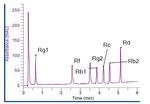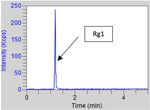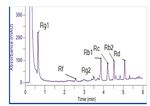Determination of Ginsenosides in Ginseng Root Powder by Flexar LC/PDA and Flexar SQ 300 MS Detector
←
→
Page content transcription
If your browser does not render page correctly, please read the page content below
APPLICATION NOTE
UHPLC/Mass Spectrometry
Authors:
Njies Pedjie
Avinash Dalmia
PerkinElmer, Inc.
Shelton, CT USA
Determination of
Ginsenosides in Introduction
The root of the ginseng plants has
Ginseng Root Powder been used as herbal medicine in
by Flexar LC/PDA and Asia for over two thousand years.
It is purported to possess antioxidant,
Flexar SQ 300 MS Detector anticarcinogenic, anti-inflammatory,
antihypertensive and anti-diabetic
properties. The pharmacologically
active compounds behind the claims of ginseng's efficacy are ginsenosides; their
underlying mechanism of action, although not entirely elucidated, appears to be similar
to that of steroid hormones. There are a number of ginseng species, and each has its
own set of ginsenosides. Ginsenosides are a diverse group of steroidal saponins with a
four ring-like steroid structure that are concentrated primarily in the roots of ginseng
plants (see structures in Figure 1). There are two main groups of ginsenosides: the
panaxadiol, or Rb1, group that includes Rb1, Rb2, Rc, Rd, Rg3, Rh2, and Rh3; and the
panaxatriol, or Rg1, group that includes Rg1, Re, Rf, Rg2 and Rh1. Among ginseng
plants, the American ginseng and the Korean ginseng are used more frequently.
Although both have similar ginsenosides, the American ginseng (Panax quinquefolius)
is said to be richer in Rb1 group ginsenosides whereas the Korean ginseng (Panax
ginseng) is richer in ginsenosides of the Rg1 group. It is noteworthy that those
attributes depend on the age of the roots when the plant was harvested, the storage
conditions, and the duration of storage.This application note presents a robust LC method to vortexing, sonication and centrifugation as described
simultaneously detect seven common ginsenosides . The above. This latter supernatant was collected and added to
analysis was achieved using a PerkinElmer® Flexar™ FX-15 the supernatant collected earlier, the 50 mL volumetric
with a PDA detector. The analysis was furthered with Flexar flask was then brought to volume with diluents. Samples
SQ 300 MS; the MS detector with its high sensitivity and were mixed well and filtered through a 0.2 µm nylon
ability to separate compounds by masses, lowered the membrane prior to testing.
threshold of detection and allowed for the separation of
Rg1 and Re, which typically co-eluted. LC/ PDA Chromatographic Conditions
Autosampler: Flexar FX UHPLC
50 µL loop and 15 µL needle volume,
LC/ PDA Analysis
partial loop mode
Experimental
Injector Wash: water
A 1 mg/mL stock of each ginsenoside (Rg1, Rf, Rg2, Rb1,
Rc, Rd, Rb2) was prepared by dissolving the appropriate net Injection Vol.: 2 µL
weight with 70:30 methanol/water (diluent) followed by Sample Diluents: 70:30 methanol/water
one minute of vortexing. A working standard of 0.14 mg/
PDA Detector: Analytical wavelength 203 nm
mL was prepared by mixing 0.5 mL of each of the stock
solutions.Precision was evaluated with five injections of UHPLC Column: PerkinElmer Brownlee™ SPP C-18,
the working standard. Linearity was determined across a 3 50 x 2.1 mm, 2.7 µm at 45 °C,
7- 140 µg/mL range. The accuracy of the method was Cat# N9308402
assessed by spiking purified water with the working Mobile Phase: A: water
standard so as to obtain a solution with 7 µg/mL B: acetonitrile
ginsenosides. The ginseng sample was prepared by Time Flow rate
transferring about 3 g of a panax ginseng powder from (min) (mL/min) B% Curve
capsules into a 50 mL volumetric flask, 30 mL of diluent
was added, followed by about a minute vortexing and 2.5 0.4 30-35 1
30 min. sonication. The solution was centrifuged at 5000 3.5 0.4 35-50 1
RPM for 10 min; the supernatant was transferred into a 3 min. equilibration after each run
50 mL volumetric flask and set aside. 15 mL of diluent
Sampling Rate: 5 pt/s
was added to the remaining precipitate, followed by
Software: Chromera® Version 3.0
Results and Discussion
The optimal flow rate was determined to be 0.4 mL/min.
at 45 °C, with pressure stabilizing around 5150 PSI (355
bar). All the peaks eluted within six minutes. Representative
chromatograms of the standards solution and the Korean
ginseng solution are shown in Figures 2 and 3. Excellent
method performance was achieved with the coefficient of
determinations no less than 0.998, and precisions with
values ranging from 0.6% to 1.2%. RSD. The purified
water spiked with working standard had a recovery of
99.9% with values ranging from 91.2% to 108.0%.
Ginsenoside R3 R2 R1 Details of the method performance and results
Rb1 group -O-Glc(6-1)Glc -H -O-Glc(2-1)Glc of the samples analyzed are presented in Table 1.
Rg1 group -OH -O-Glc O-Glc
Figure 1. Molecular structure of ginsenosides.
Glc Glucopyranoside (β-D-Glucose).
2Figure 2. Chromatogram of the standard solution. Figure 3. Chromatogram from the analysis of panax ginseng.
Table 1. Precision, linearity, accuracy and samples.
Compound %RSD r² Range (µg/mL) Korean Ginseng mg/g 7 ppm Spiked
Rg1 0.9 0.9997 7 - 140 13 97.5
Rf 0.6 0.9971 7 - 140 1 91.2
Rg2 1.2 0.9983 7 - 140 1 98.7
Rb1 1.1 1 7 - 140 10 102.1
Rc 1.2 0.9994 7 - 140 10 100.3
Rb2 1.0 0.9996 7 - 140 7 101.4
Rd 1.2 0.9997 7 - 140 4 108.0
Average/Total 1.0/- 0.9988/- -/46 99.9/-
MS Analysis LC Conditions
Autosampler: 50 µL loop and 15 µL needle volume,
During the analysis using a PDA detector, there was
partial loop mode
suspicion that ginsenoside Rg1 and ginsenoside Re
co-eluted. To achieve their separation, a MS detector was Injection Vol.: 5 µL
used. A new standard solution including Re was prepared Injector Wash: water
and the ginseng extract was further analyzed.
Column: Brownlee™ SPP C18 column (2.1 mm x
5050 mm, 2.7 μm) at 45 °C,
LC/ MS Analysis Cat# N9308402
Experimental Sample Diluents: 0.5% acetic acid in 70:30
From six stock standards (Rg1, Re, Rb1, Rc, Rd, Rb2 ) methanol/water
prepared in the same way as the stock standard in the PDA
Mobile Phases: A: 0.4 mM ammonium acetate in
analysis, seven calibration standards, with concentration
0.1% acetic acid
ranging from 0.1 µg/mL to 100 µg/mL (0.1, 0.3, 1, 3, 10,
B: ACN with 0.1 % Acetic Acid
30, 100 µg/mL), were prepared by dilution, with the same
diluents to which 0.5% acetic acid was added. The Ginseng Time Flow rate
sample prepared for the LC/PDA analysis was diluted 50 (min) (mL/min) B% Curve
times (0.2 ml in 10 mL vol. flask) with 1% acetic acid in 0.5 0.5 20 1
70/30 methanol/water.
1.0 0.5 20-35 1
3.5 0.5 35-50 1
3Mass Spec Conditions The optimal flow rate of this method was determined to be
Source: ESI in negative ion mode 0.5 mL/min. at 45 °C. All the peaks eluted within six minutes.
Drying Gas The calibration curves’ r-square ranged from 0.9971 to
Temp and flow: 350 °C and 15 L/min 0.9997 (Figure 4). The MS allowed the identification and
quantification of Re, and Rg1; although both eluted at the
Nebulizer
same time they have different masses. The Sim scan showing
Gas Pressure: 80 psi
Rg1 and Re in the standard solution and the Ginseng abstract
SIM solution are in Figures 5-8. Results of the MS analysis of Rg1,
Dwell Time: 50 ms and Re are shown in Table 2.
SIM Mass: 799.5 for Rg1, 945.6 for Rd, Re, 1077.6
for Rb2, Rc, 1107.6 for Rb1
Capillary
Exit Voltage: -150 V for Rg1, Rd, Re, -165 V
forRb2,Rc,Rb1
m/z Range: 100-1200 Da
Scan Rate: 4000 Da/s
Capillary
Exit Voltage: 180 V in scan mode
Figure 4. Calibration curves.
Figure 5. Rg1 from the std solution at 10 ppm. Figure 6. Re and Rd from the std solution at 10 ppm.
4Figure 7. Korean ginseng extract at (masses). Figure 8. Korean ginseng extract at (masses).
Table 2. Rg1/Re results References
Compound Korean Ginseng Extract (mg/g)
1. R
ebecca M. Corbit, Jorge F. S. Ferreira, Stephen D. Ebbs,
Rg1 2.2
and Laura L. Murphy.
Re 11.3
Simplified Extraction of Ginsenosides from American
Total 13.5
Ginseng for High-Performance Liquid Chromatography-
Ultraviolet Analysis, J. Agric. Food Chem. 2005, 53,
9867-9873 9867.
Conclusion
2. A
ttele, A. S.; Wu, J. A.; Yuan, C.-S. Ginseng
Using a PDA detector, seven ginsenosides were resolved
pharmacology: multiple constituents and multiple actions.
within six minutes. The method was shown to be linear
Biochem. Pharmacol.1999, 58, 1685-1693.
with r square ≥ 0.998, precise with %RSD ≤ 1.2 and
accurate with a recovery averaging 99 %. The Korean http://mend.endojournals.org/content/22/1/186.full
ginseng capsule analyzed has 46 mg/g of ginsenosides. http://www.cmjournal.org/content/pdf/1749-8546-7-2.pdf
Analysis with MS proved that Rg1 detected
(13 mg/g) with the PDA was in fact a co-eluted Rg1 Note: this application is subject to change without notice.
(2.2 mg/g) and Re (11.3 mg/g).
PerkinElmer, Inc.
940 Winter Street
Waltham, MA 02451 USA
P: (800) 762-4000 or
(+1) 203-925-4602
www.perkinelmer.com
For a complete listing of our global offices, visit www.perkinelmer.com/ContactUs
Copyright ©2009-2013, PerkinElmer, Inc. All rights reserved. PerkinElmer® is a registered trademark of PerkinElmer, Inc. All other trademarks are the property of their respective owners.
011195_01You can also read

























































